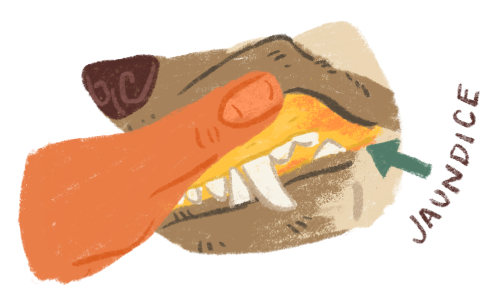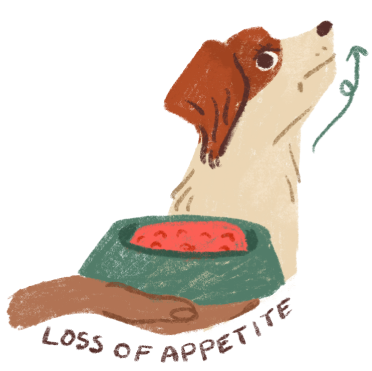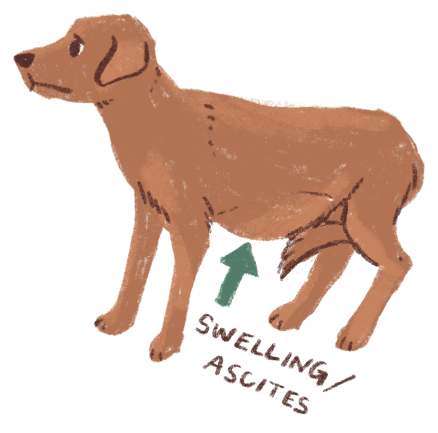Understanding the Early Signs of Liver Disease in Pets

By Dr Nicole Rous, Integrative Vet
As pet owners, we cherish every moment with our furry friends and strive to keep them happy and healthy. Amidst the daily joys of wagging tails and puppy cuddles, it is important to be aware of potential health concerns that can affect our pets.
Just like in humans, liver disease can affect our pets, leading to serious health issues if left unchecked. Thankfully, liver disease is highly treatable, often with a change in diet and holistic veterinary treatment. Recognising the early signs of liver disease and knowing the best care for your pet is essential for timely intervention and treatment.
In this guide we will explore the signs and symptoms of liver disease in dogs and discuss different options for diet and treatment. From changes in appetite and behaviour, to more visible symptoms, such as jaundice. Understanding these signs can make all the difference in your pet’s well-being.
Learn the warning signs, common causes and proactive measures you can take to support your pet’s liver function. Let’s ensure our pets live their happiest, healthiest lives by staying informed and proactive about liver disease.
The Role of the Liver:
The liver plays a key role in metabolism, by regulating energy production and storing nutrients. The liver also detoxifies blood by filtering out harmful substances. Additionally, the liver produces bile, which aids in digestion by breaking down fats and absorbing essential nutrients from food.1
Essentially, the liver acts as a powerhouse, supporting various processes that are crucial for our dog’s well-being and vitality.
Signs and Symptoms of Liver Disease in dogs:

Jaundice (yellowing of the skin, gums or whites of the eyes):
This occurs due to elevated bilirubin levels in the bloodstream

Loss of appetite:
Dogs with liver disease may show a reduced interest in food

Weight loss:
Unexplained weight loss can be a sign of chronic liver disease

Vomiting and diarrhoea:
Gastrointestinal disturbances are common, often due to impaired bile flow

Increased drinking and urination:
Some dogs may drink more water and urinate more frequently, their urine may be a darker colour

Lethargy and weakness:
Some dogs may appear more tired and less active than usual

Swelling/Ascites:
Fluid accumulation in the abdomen may lead to a swollen stomach, often painful when touched

Neurological signs:
In advanced cases, disorientation, seizures, eye-sight deterioration and behavioural changes can occur due to the liver no long detoxifying substances
If you notice any of these symptoms in your dog, it is important to consult your veterinarian, early diagnosis and treatment can improve outcomes for dogs with liver disease.(1),(2)
Common Causes of Liver Disease in dogs:
- Infections and Toxins: Bacterial and viral infections, as well as ingestion of certain chemicals and toxins often affect and damage the liver
- Genetics: Certain dog breeds are predisposed to genetic liver conditions
- Autoimmune Diseases: The immune system can attack the liver, leading to liver disease
- Obesity: Overweight dogs often experience fatty liver disease
- Diet and Nutrition: Poor diet and non-absorbable nutrition can lead to nutritional deficiencies, impacting the health of the liver(2),(3)
Recommendations and Advice for Dogs with Liver Disease:
Before making any changes, consult your veterinarian to understand what your dog is facing. Liver disease can be acute or chronic and having specific guidance based on your dog’s individual conditions and needs is incredibly beneficial. Your vet may recommend a feeding tube, fluid drip or antibiotics to help with infection, dehydration and appetite suppression.(2),(3)
Consider consulting a canine nutritionist or holistic veterinarian for recommendations. A change in diet can support your dog with liver disease, a high-quality protein source, low fat diet that is easy to digest and process will benefit your dog's liver function and overall well-being. A low-fat diet is easier for the liver to process.(2),(3)
A raw diet will also provide the vitamins, minerals and hydration your dog’s liver needs. It is important to ensure fresh water is always available to your dog, especially when dealing with liver disease.
Continue monitoring your dog's symptoms and organise regular check-ups to ensure optimal liver function and adjust your dog's diet as necessary/as recommended.
You can find more advice on prevention and treatment of liver disease, from Holistic Veterinarian, Dr Edward Bassingthwaighte here:
Liver Disease in Dogs: Early Signs and Symptoms, Holistic Prevention and Treatment
Key Take Aways:
Recognising the signs and symptoms of liver disease is crucial for timely intervention and management.
The most common symptoms to watch out for are jaundice and changes to appetite and urine.
Consider a raw diet for both prevention and treatment of liver disease in dogs. Potential benefits of a raw food diet for dogs with liver disease include nutrient bioavailability and reduced intake of additives. Check out Nourish Nutrition Optimal Support.
Please reach out to our team here if you have any questions regarding liver disease in dogs.
About the Author - Dr. Nicole Rous

Dr. Nicole Rous completed her degree with Honours from the University of Sydney in 2008. She initially worked in the UK before returning to small animal practice in Melbourne, Australia. Dr. Nicole has a keen interest in animal reproduction and has been granted Membership with the Australian and New Zealand College of Veterinary Scientists in this specialty. She is also passionate about complementary therapies such as massage and enjoys discussing ways to enhance pets' overall well-being and quality of life.
In August 2021, Dr. Nicole joined the Mont Albert Veterinary Surgery team as a director and continues to provide exceptional care to her patients. She is dedicated to utilising her knowledge and experience to assist pets in living longer, healthier, and happier lives.
Dr. Nicole's commitment to providing natural and holistic health practices for pets inspired her to establish Shy Tiger, a company that offers natural pet products made from premium ingredients sourced primarily from Australian farms and producers. Her expertise in natural health practices and dedication to providing excellent care to her patients make her a reliable partner for pet owners in Melbourne and beyond.
References:
(1). Bassingthwaighte, E (2024). Liver Disease in Dogs: Early Signs and Symptoms, Holistic Prevention and Treatment Retrieved 17 July 2024.
(2). Scott, D (2022). How To Spot The Early Signs Of Liver Disease In Dogs. Retrieved 17 July 2024.
(3). Karlsen, S (2024). Liver disease in dogs. Retrieved 17 July 2024.
